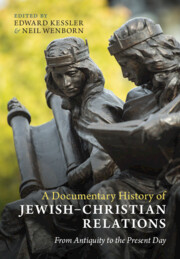140 results
5 - From the Reformation to the Enlightenment
- from Part II - 900 to 1800
-
-
- Book:
- A Documentary History of Jewish–Christian Relations
- Published online:
- 03 October 2024
- Print publication:
- 17 October 2024, pp 233-286
-
- Chapter
- Export citation

A Documentary History of Jewish–Christian Relations
- From Antiquity to the Present Day
-
- Published online:
- 03 October 2024
- Print publication:
- 17 October 2024
3 - Puritanism and Predestination
- from Part I - The Origins of Cambridge Platonism
-
- Book:
- The Cambridge Platonists and Early Modern Philosophy
- Published online:
- 09 May 2024
- Print publication:
- 16 May 2024, pp 61-87
-
- Chapter
- Export citation
11 - Sex in Geneva in the Sixteenth Century
-
-
- Book:
- The Cambridge World History of Sexualities
- Published online:
- 26 April 2024
- Print publication:
- 16 May 2024, pp 210-231
-
- Chapter
- Export citation
Intercession and Anamnesis in the Eucharist
-
- Journal:
- Journal of Anglican Studies , First View
- Published online by Cambridge University Press:
- 27 March 2024, pp. 1-15
-
- Article
-
- You have access
- Open access
- HTML
- Export citation
10 - British Reformations Compared
-
-
- Book:
- Reformations Compared
- Published online:
- 14 March 2024
- Print publication:
- 21 March 2024, pp 214-241
-
- Chapter
- Export citation
5 - Beyond Toleration
-
-
- Book:
- Reformations Compared
- Published online:
- 14 March 2024
- Print publication:
- 21 March 2024, pp 104-123
-
- Chapter
- Export citation
9 - Tales of the Unexpected
-
-
- Book:
- Reformations Compared
- Published online:
- 14 March 2024
- Print publication:
- 21 March 2024, pp 190-213
-
- Chapter
- Export citation
8 - Reformations in the Low Countries
-
-
- Book:
- Reformations Compared
- Published online:
- 14 March 2024
- Print publication:
- 21 March 2024, pp 167-189
-
- Chapter
- Export citation
6 - Nordic Reformations Compared
-
-
- Book:
- Reformations Compared
- Published online:
- 14 March 2024
- Print publication:
- 21 March 2024, pp 124-145
-
- Chapter
- Export citation
1 - Saxon Comparisons
-
-
- Book:
- Reformations Compared
- Published online:
- 14 March 2024
- Print publication:
- 21 March 2024, pp 19-41
-
- Chapter
- Export citation
3 - Austria and Bohemia
-
-
- Book:
- Reformations Compared
- Published online:
- 14 March 2024
- Print publication:
- 21 March 2024, pp 61-79
-
- Chapter
- Export citation
4 - In the Shadow of the Crescent Moon
-
-
- Book:
- Reformations Compared
- Published online:
- 14 March 2024
- Print publication:
- 21 March 2024, pp 80-103
-
- Chapter
- Export citation
11 - The Reception of the Protestant Reformation in the Iberian Peninsula
-
-
- Book:
- Reformations Compared
- Published online:
- 14 March 2024
- Print publication:
- 21 March 2024, pp 242-265
-
- Chapter
- Export citation
7 - The Reformations along the Southern Baltic Littoral
-
-
- Book:
- Reformations Compared
- Published online:
- 14 March 2024
- Print publication:
- 21 March 2024, pp 146-166
-
- Chapter
- Export citation
Introduction
-
-
- Book:
- Reformations Compared
- Published online:
- 14 March 2024
- Print publication:
- 21 March 2024, pp 1-18
-
- Chapter
- Export citation
3 - Disclosure
- from Part II - Conduct Controls: Welfare and Pension Plans
-
- Book:
- ERISA Principles
- Published online:
- 15 February 2024
- Print publication:
- 22 February 2024, pp 61-115
-
- Chapter
- Export citation
Chapter 8 - Religion
- from Part II - Contexts and Controversies
-
-
- Book:
- The Cambridge Companion to Literature and Animals
- Published online:
- 26 October 2023
- Print publication:
- 09 November 2023, pp 153-169
-
- Chapter
- Export citation
8 - The Reformation and National Identity
- from Part ii - Paradigm Shifts and Turning Points in the Era of Globalization, 1500 to the Present
-
-
- Book:
- The Cambridge History of Nationhood and Nationalism
- Published online:
- 27 October 2023
- Print publication:
- 09 November 2023, pp 163-185
-
- Chapter
- Export citation
Chapter 25 - The Puritan Threat, the Church of England and the Personal Rule as a Period of Reformation
- from Part III - Laudianism: What It Wasn’t
-
- Book:
- On Laudianism
- Published online:
- 05 October 2023
- Print publication:
- 19 October 2023, pp 337-350
-
- Chapter
- Export citation

